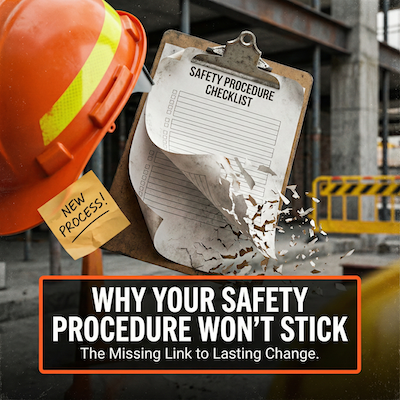Back to the Future of Construction Safety Management
In an industry where a single misstep can have serious consequences, it's no surprise that construction leaders are constantly seeking new ways to improve safety and performance. However, as Bob the Builder so aptly put it, "Can we fix it? Yes, we can!"
As we venture into the future of construction safety management, it's crucial to look at the wisdom of great management thinkers and their potential impact on this ever-evolving landscape.
In this blog post, we'll explore how the ideas of Peter Drucker, W. Edwards Deming, and Peter Senge can contribute to a safer work environment, and how the groundbreaking PERMA model, developed by Martin Seligman, can usher in a new wave of construction safety management that focuses on rewarding positive outcomes.
Grab a cuppa, sit back, and let's get stuck into it.

Drucker's Management Principles in Construction Safety
Peter Drucker, affectionately known as the "father of modern management," offers valuable insights that can be applied to the world of construction safety. Drucker emphasised the importance of clear objectives and effective leadership, both of which are crucial components in fostering a safe work environment.
1. Management by Objectives (MBO)
Drucker's MBO approach involves setting specific, measurable, achievable, relevant, and time-bound (SMART) goals. In the context of construction safety, this means establishing clear safety targets and continuously monitoring progress.
When workers and management are on the same page regarding safety expectations, potential hazards can be more easily identified and mitigated. As the old Aussie saying goes, "A team that knows its goals is a team that's fair dinkum about safety."
2. The Effective Executive
Drucker also outlined several key traits of effective executives, such as focusing on results, prioritising time, and building on strengths. Construction leaders who embody these traits can cultivate a safety culture that not only complies with regulations but goes above and beyond to protect workers.
After all, when the boss is committed to safety, it's likely that everyone else will follow suit. In a nutshell, a good leader can be the difference between "She'll be right" and "Crikey, we've got a problem!"
With Drucker's management know-how, construction bosses can create a safety culture that makes accidents scarcer than a dingo's dentist.

Deming's System of Profound Knowledge in Construction Safety
W. Edwards Deming, a renowned management consultant and statistician, made significant contributions to the world of quality management. His insights, particularly the System of Profound Knowledge and the Deming Cycle, can play a pivotal role in enhancing construction safety.
1. The Deming Cycle (PDCA)
Deming's Plan-Do-Check-Act (PDCA) cycle is all about continuous improvement. In the realm of construction safety, this means systematically identifying potential hazards, implementing corrective measures, and evaluating their effectiveness.
By consistently following the PDCA cycle, construction companies can ensure that safety practices are always up to snuff, much like a well-maintained barbie on a hot summer day.
2. Variation, Systems Thinking, and Safety
Deming also emphasised the importance of understanding and managing variations in processes. In construction, this translates to recognising that every project is unique and requires tailored safety measures.
If construction leaders warm up to Deming's notions of constant betterment, variation, and systems thinking, they'll turn safety into something as fundamental as the foundations of the buildings they're putting up. Deming was spot on when he said, "Quality is everyone's responsibility;" That also holds true for keeping everyone in one piece on the construction site.

Senge's Learning Organisation in Construction Safety
Peter Senge, a thought leader in organisational learning and systems thinking, introduced the concept of the Learning Organisation, which emphasises the importance of adaptability and continuous learning. By embracing Senge's principles, construction leaders can foster a safer work environment that constantly evolves to address emerging challenges.
1. Shared Vision and Team Learning:
Senge believed that a shared vision is essential for an organisation's success. In construction safety, creating a collective understanding of safety goals and expectations encourages teamwork and collaboration. Team learning, on the other hand, focuses on improving the team's problem-solving capabilities.
By nurturing a culture of open communication and shared learning, construction companies can identify potential hazards, develop innovative solutions, and reinforce the idea that "mates look out for mates" on the worksite.
2. Systems Thinking and Safety:
Senge's systems thinking approach involves understanding the interconnections within an organisation and recognising how individual components influence the whole. Applying this holistic perspective to construction safety enables leaders to address underlying issues and develop comprehensive strategies that take into account the complexity of construction projects.
As the saying goes, "You can't see the forest for the trees," and adopting a systems thinking approach ensures that construction leaders can appreciate the bigger picture when it comes to safety.
3. Collaboration for Safety:
Senge's Learning Organisation principles highlight the importance of fostering strong relationships among team members. In construction, collaboration is essential for maintaining a safe working environment.
By encouraging open dialogue and cooperation, construction leaders can create a culture where workers are empowered to voice their concerns, share their expertise, and contribute to the development of robust safety practices.
It's all about getting everyone on board, from the sparkies to the brickies, to ensure that safety is ingrained in the company's DNA.
By implementing the principles of Senge's Learning Organisation, construction companies can create a flexible, adaptable, and safety-conscious work environment that continuously improves and evolves. The result? A construction site that's as safe as a fall-protected koala snoozing in a gum tree, and a workforce that's ready to tackle the challenges of tomorrow.

Seligman's PERMA Model in Construction Safety
Martin Seligman, a pioneer in the field of positive psychology, developed the groundbreaking PERMA model, which focuses on five core elements of psychological well-being and happiness: Positive emotion, Engagement, Relationships, Meaning, and Accomplishment.
By applying this model to construction safety, leaders can create a safety culture that goes beyond compliance and actively encourages safe behaviour.
1. Positive Emotion and Safety
Encouraging a positive mindset and attitude toward safety is essential for creating a proactive safety culture. Construction leaders can cultivate positive emotions by celebrating safety achievements, sharing success stories, and acknowledging employees' safe actions.
Remember, a little praise goes a long way – it's like a pat on the back or a "good on ya, mate!" that boosts morale and reinforces the importance of safety.
2. Engagement, Relationships, and Safety
Employee engagement is crucial for maintaining a safe working environment. Construction leaders can promote engagement by involving employees in decision-making processes, providing training opportunities, and encouraging open communication regarding safety concerns.
Fostering strong relationships among team members is equally important, as it creates a supportive work environment, emphasises teamwork, and encourages collaboration in addressing safety issues.
When workers are engaged and connected, they're more likely to look out for each other and follow safe work practices – after all, teamwork makes the dream work!
3. Meaning, Accomplishment, and Safety
Establishing a clear sense of purpose and meaning behind safety initiatives is vital for driving positive change. By connecting safety goals to the organisation's mission and values, construction leaders can inspire employees to take ownership of their actions and recognise the importance of protecting one another.
Accomplishment, on the other hand, focuses on setting challenging but achievable safety goals and recognising employees for their achievements in reaching these goals. By rewarding safe behaviour and celebrating milestones, construction companies can reinforce the value of safety and motivate employees to strive for continuous improvement.
By implementing a "Positive Safety Culture" based on Seligman's PERMA model, construction leaders can introduce an innovative approach to construction safety that emphasises the importance of positive reinforcement and well-being. This approach not only aligns with the ideas of great management thinkers but also adapts to the evolving needs of the industry, paving the way for a safer, more resilient construction sector.
It's in this context that Scratchie, an app designed to reward safe work, emerges as a game-changer, facilitating the implementation of these ideas and empowering companies to create an environment where workers are safer and more engaged. Reach out to us if you'd like more information.










.svg)
